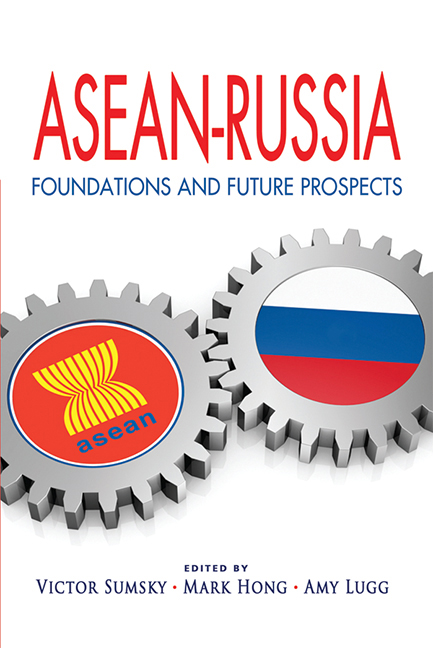Book contents
- Frontmatter
- Contents
- Foreword
- Preface
- About the Contributors
- Keynote Address
- Opening Remarks
- Keynote Address
- Introduction: Russia and the ASEAN Member States: Political and Economic Cooperation in Progress
- SECTION I WISEMEN'S VIEWS
- SECTION II GEOPOLITICS
- Russia in Southeast Asia: A New “Asian Moment”?
- ASEAN-Russia Military Ties: Reconfiguring Relations
- The Enlargement of the East Asia Summit: The Reasons and Implications of Bringing Russia In
- Russia's Entry into ASEM: Not Just a Courtesy Call?
- Russia-India-China: Acting in Concert in Southeast Asia?
- The South China Sea Issue: A View from Russia
- Southeast Asia and Russia: Forging a New Regional Architecture
- Russia-ASEAN Relations: An Indian Perspective
- SECTION III BILATERAL RELATIONS
- SECTION IV Business and Economics
- SECTION V CULTURE AND EDUCATION
- EPILOGUE
- Index
ASEAN-Russia Military Ties: Reconfiguring Relations
from SECTION II - GEOPOLITICS
Published online by Cambridge University Press: 21 October 2015
- Frontmatter
- Contents
- Foreword
- Preface
- About the Contributors
- Keynote Address
- Opening Remarks
- Keynote Address
- Introduction: Russia and the ASEAN Member States: Political and Economic Cooperation in Progress
- SECTION I WISEMEN'S VIEWS
- SECTION II GEOPOLITICS
- Russia in Southeast Asia: A New “Asian Moment”?
- ASEAN-Russia Military Ties: Reconfiguring Relations
- The Enlargement of the East Asia Summit: The Reasons and Implications of Bringing Russia In
- Russia's Entry into ASEM: Not Just a Courtesy Call?
- Russia-India-China: Acting in Concert in Southeast Asia?
- The South China Sea Issue: A View from Russia
- Southeast Asia and Russia: Forging a New Regional Architecture
- Russia-ASEAN Relations: An Indian Perspective
- SECTION III BILATERAL RELATIONS
- SECTION IV Business and Economics
- SECTION V CULTURE AND EDUCATION
- EPILOGUE
- Index
Summary
On a blustery morning in the summer of 1989, under an overcast sky, a Soviet warship off the port of Vladivostok fired a sophisticated anti-ship missile at a distant target. Unseen from the vessel's deck, the exercise was being monitored by the U.S. Navy's Knox-class frigate USS Harold E. Holt.
There was some confusion following the launch, punctuated by discussion. A Soviet escort officer eventually turned to the group of assembled observers, which included a scattering of media, to state that a second missile would be fired. “The Japanese television crew missed the shot”, he explained in English, adding ruefully: “Those missiles each cost a quarter of a million dollars.”
This event, a major exercise of the Soviet Pacific Fleet conducted on 11–12 July 1989, was deeply significant as the first official opportunity offered foreign observers to view Soviet naval manoeuvres in the Pacific. Coming three years after the seminal Vladivostok address by Soviet leader Mikhail Gorbachev, which saw Moscow turn towards Asia and most notably foreshadowed a rapprochement with China, the exercise aimed to send the region a reassuring message.
Soviet staff officers stressed to observers the defensive nature of the exercise, a radical reverse from the offensive stance previously emphasized. But much of the region remained suspicious, understandably confused by the monumental changes under way in the Soviet Union.
Moscow invited fifteen Pacific Rim countries to send military observers, but just four complied: India, Indonesia, Malaysia and Vietnam. It was nevertheless a start. “Regardless of how few (foreign military) observers are attending it is quite satisfactory to see the ice being broken”, the fleet commander, Admiral Gennady Khvatov, observed.
THE REGION AL CONTE XT
“Let us turn our faces towards Asia”, the Soviet icon Vladimir Lenin exhorted his followers when the worker's uprising in Europe failed to materialize. “The East will help us conquer the West.”
- Type
- Chapter
- Information
- ASEAN-RussiaFoundations and Future Prospects, pp. 58 - 69Publisher: ISEAS–Yusof Ishak InstitutePrint publication year: 2012

